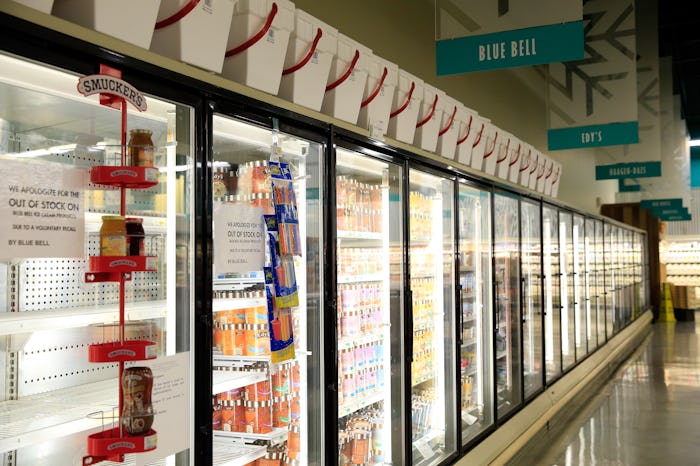Life

How To Tell If You Have A Listeria Infection, Because Early Detection Is Crucial
Listeria outbreaks seem to be distressingly common. With a major Trader Joe's recall announced this May, shoppers may be left wondering what to do if they've actually consumed contaminated food. Though not all listeria infections lead to severe illness, knowing how to tell you if you have listeria may save your life.
Though listeria is found in soil, water, and animals, it can grow in processing facilities and refrigerators, the Los Angeles Times reported. Listeria made news this month when CRF Frozen Foods recalled more than 350 products, according to AOL News; all were frozen fruits and vegetables. Since Trader Joe's carried some of its products, the grocery chain launched a recall of its own that's expanded multiple times over the last few weeks. Most recently, the company recalled Trader Joe's Chicken Fried Rice and Trader Joe's Vegetable Fried Rice of all lot and date codes. The initial Trader Joe's recall announced on May 3 included store brand Organic Peas, Petite Peas, Organic Whole Green Beans, Organic Broccoli Florettes, and Organic Foursome (the full overview of applicable codes can be found on Trader Joe's website). On May 5, the chain added Organic Super Sweet Cut Corn to the list.
CRF Frozen Foods and Trader Joe's aren't the only companies grappling with listeria concerns. SunOpta launched a sunflower kernel recall last week, according to CNN. And on Wednesday, Publix recalled prepackaged cranberry nut and seed mix due to the possibility of compromised walnuts, CNN reported.
Lucky shoppers spot a recall before eating a contaminated product. But if someone doesn't get the news in time, how can they tell if they've got listeriosis? Symptoms of a listeria infection include "fever, muscle aches, nausea, [and] diarrhea," according to Mayo Clinic; they may manifest in days or in months after eating. If the infection makes its way to the nervous system, symptoms are more substantial and may include "headache, stiff neck, confusion or changes in alertness, loss of balance, [and] convulsions." Unfortunately, listeriosis symptoms are similar to those of many other illnesses; it may be difficult to tell when it's essential to get tested specifically for listeria. The Centers for Disease Control and Prevention (CDC) advises that it's particularly important to get a medical evaluation for listeriosis "If you become very sick with fever and muscle aches or stiff neck, or if you develop fever and chills while pregnant." A doctor can find listeria either in the blood or in spinal fluid.
It's critical for pregnant women to pay attention to symptoms of listeria infection, even if they're mild. Listeriosis can lead to serious pregnancy complications, according to Mayo Clinic: a woman may have a miscarriage, the baby may be stillborn, or the baby may be born prematurely. A fetus may also contract a listeria infection from the mother that could manifest after birth as a fatal illness. It's common for pregnant women's listeriosis symptoms to include fever, fatigue, and aches, the CDC reported, which are all symptoms that may not seem that unusual during pregnancy. If a pregnant person has any question at all about the possibility of listeria infection, they should consult with a physician as soon as possible. The same advice applies to anyone with a weakened immune system and anyone over the age of 65.
Listeria is certainly a problem in the United States: listeriosis kills about 260 people and infects around 1,600 per year, according to the CDC. The good news is that listeria infections are treatable with antibiotics, Mayo Clinic reported. Early antibiotic treatment during pregnancy can also protect the fetus. In addition to paying attention to recalls, there are steps individuals can take to lower their risk of contracting the bacteria. Keeping the kitchen clean is essential to preventing listeria growth, the CDC reported. Mop up spills (particularly from uncooked food and lunchmeat packages) quickly, wipe out the refrigerator with liquid soap and hot water frequently, and keep the fridge and freezer at the proper temperature (no higher than 40°F and 0°F, respectively).
Though plenty of people love rare steaks and a bit of pink in their burgers, it's important to cook meat to the optimal internal temperature; FoodSafety.gov has a helpful chart of "Safe Minimum Cooking Temperatures." Keep meat stored away from all other food, and wash and dry fruit and vegetables thoroughly before eating (there are special instructions for melons available on the CDC website). It's also essential to pay attention to use-by dates and store leftovers for no longer than four days.
Certain products and ingredients are more susceptible to contamination than others. Some foods at risk for listeria contamination include seafood (both canned and raw), fruits, meats (preserved and smoked), root vegetables, "ground-grown vegetables," and any foods that require long-term refrigeration (such as cheeses), Forbes reported. Most people don't need to avoid these foods as long as they're sourced, prepared, cooked, and stored properly (though the CDC recommends all people avoid unpasteurized milk). Pregnant women may want to cut out whole categories of food to lower their listeriosis risk; full guidelines for what meats, soft cheeses, and seafood to skip are available on the CDC's website.
Listeria outbreaks are scary, but knowing how to shop and cook safely is key to lowering the risk of infection.